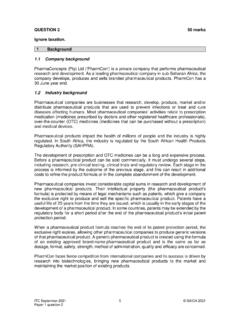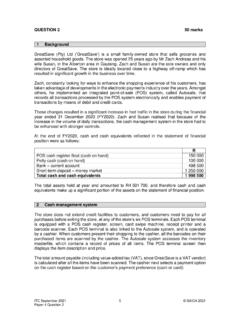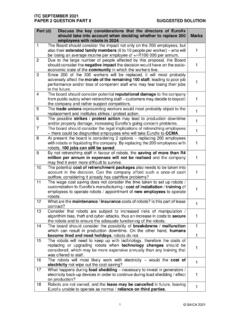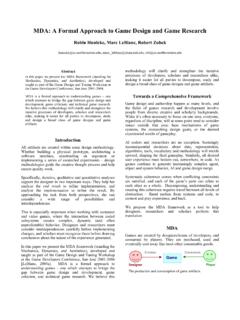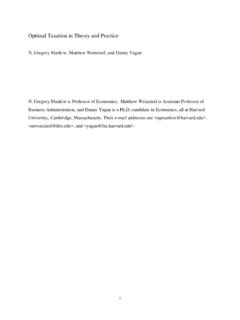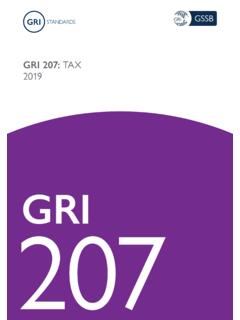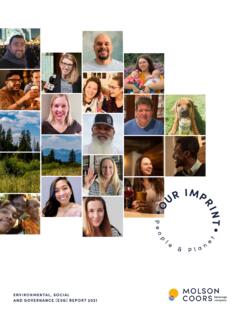Transcription of TAX PRACTITIONER REQUIREMENTS, REGISTRATION AND DE ...
1 TAX PRACTITIONER REQUIREMENTS, REGISTRATION AND DE- REGISTRATION . PROCESS. 1. Background Section 240 of the Tax Administration Act, 2011 (the TAA), requires every natural person who: - provides advice to another person with respect to the application of a tax Act; or - completes or assists in completing a return;. to register with or fall under the jurisdiction of an recognised controlling body' (RCB), as referred to in section 240A of the Tax Administration Act, 2011 (the TAA), by the later of 31. July 2013 or 21 business days after the date on which that person, for the first time, becomes liable to register. Such person must also register with SARS as a tax PRACTITIONER within 21. business days after becoming liable to register. Certain exceptions do apply as set out in section 240 of the TAA.
2 The TAA, defines certain bodies to be recognised controlling bodies (RCBs). They are: - the Independent Regulatory Board for Auditors (IRBA);. - a Law Society established in terms of Chapter 3 of the Attorneys Act, 1979;. - the General Council of the Bar of SA, a Bar Council and a Society of Advocates referred to in Section 7 of the Admission of Advocates Act, 1964;. - a statutory body that the Minister is satisfied is similar to the statutory bodies listed above. The Act further stipulates that the Commissioner may recognise a controlling body, if the body: - Maintains relevant and effective: - minimum qualifications and experience requirements;. - continuing professional education requirements;. - codes of ethics and conduct; and - disciplinary codes and procedures.
3 - is approved in terms of section 30B of the Income Tax Act, 1962, for purposes of Section 10 (1)(d)(iv) of that Act; and - has at least 1 000 members when applying for REGISTRATION or reasonable prospects of having 1 000 members within a year of applying. SAICA, together with a number of other professional bodies applied for and were approved as RCBs, by SARS. A member of SAICA therefore does not need to register with any other body in order to register as a tax PRACTITIONER . However, there are specific requirements that members need to adhere to and steps to be taken to enable REGISTRATION . 2. Requirements for REGISTRATION In order to qualify for REGISTRATION as a tax PRACTITIONER , all SAICA members must complete the declaration form. To maintain this REGISTRATION on an ongoing basis, ALL of the following requirements must be met: 1.
4 The person must belong to or fall under the jurisdiction of an RCB; and All SAICA members (CA(SA), AGA(SA) & AT(SA)) would qualify in respect of this aspect. However, these members are required to request SAICA to submit their details to SARS for REGISTRATION purposes (see below). 2. The person must have the minimum qualifications and experience set by the relevant RCB; and SAICA members will also comply with this requirement due to the SAICA entry requirements. 3. The person must not have been removed from any other controlling body, within the last five years, as a result of serious misconduct; and 4. The person must not have criminal convictions in respect of the offences described in section 240(3) of the Tax Administration Act during the last five years, that is: - theft, fraud, forgery or uttering a forged document, perjury or an offence under the Prevention and Combating of Corrupt Activities Act, 2014; or - any offence involving dishonesty, for which such person has been sentenced to two years in person without the option of a fine or a fine exceeding the amount prescribed in the Adjustment of Fines Act, 1991; and SAICA verifies this on an annual basis as part of the annual tax PRACTITIONER declaration and audit process.
5 5. The person must not have been convicted of a serious tax offence within the last five years; and A serious tax offence is defined as a tax offence for which a person may be liable on conviction to imprisonment for a period exceeding two years, without the option of a fine; or to a fine exceeding the equivalent fine under the Adjustment of Fines Act 101 of 1991, currently R120. 000. 6. The registering member must be compliant with SAICA's code of ethics; and This may include the person being substantively compliant with all his or her personal tax affairs as at the date of REGISTRATION for new practitioners or renewal of membership for previously registered practitioners. SAICA verifies this on an annual basis as part of the annual tax PRACTITIONER declaration and audit process.
6 7. The person must participate and comply with the continuous professional development requirements as set by the RCB. The SARS requirement for tax practitioners applies from date of REGISTRATION (that is, apportionment applies). In terms of these requirements, tax PRACTITIONER members must attain an annual equivalent of at least 15 hours tax specific CPD for each year or part of the year, 60% (9 hours) of which is verifiable. The SAICA CPD policy has been amended as effective from 01 January 2020. SAICA has proposed a change in focus as the previous CPD policy promotes an input based approach and does not specifically focus on the individual as a responsible life-long learner. The current policy offers members and associates the choice of following an input or output based approach .
7 However, the assessment of an individual's CPD is based on a set number of hours per year and an accumulative number of hours over a three-year period. Although SAICA. provides members with a number of mechanisms to satisfy their CPD requirements and to enhance their professional development, SAICA is of the view that an output-based approach to CPD will promote a more holistic view of CPD and better drive the core attitude / behaviour of life-long learning. Section (h) of the new CPD policy note that members who are required to fulfil certain additional requirements set out by an external regulator operating in the specialist area in which the member or associate is working, must take responsibility for satisfying the obligations for continued REGISTRATION with this regulator / oversight body.
8 In some cases, this may require additional reporting or submissions of declarations. It is the members'. responsibility to meet both SAICA and the regulators requirements. Refer to the link: uage/en- (for SAICA CPD Policy). Note that SAICA verifies this on an annual basis as part of the annual tax PRACTITIONER declaration and audit process. 3. REGISTRATION process REGISTRATION as a tax PRACTITIONER is a two-pronged approach as, in terms of the process defined by SARS, one needs to register both with SARS and the RCB, which is, in this case, SAICA. SARS REGISTRATION - Members must first register as an eFiler, if this has not already been done. - Following this, members must register as a tax PRACTITIONER on their eFiling profile. - Guidance is provided on the SARS website and may change from time to time depending on SARS system changes.
9 It is important that members select SAICA as their designated RCB on the RAV01 ( REGISTRATION , amendment and verification form) on their eFiling profile. SAICA REGISTRATION - During the 2018 year, SAICA introduced a tax PRACTITIONER regulatory subscription fee to cover the cost of regulating tax practitioners. Please read this notice for more details on the fee. This fee is applicable from the 2018 membership year, going forward. However, the amount is subject to change. No concessions have been granted to lifetime members or members with smaller practices as the cost to regulate is the same, per member, regardless of specific circumstances. - SAICA's membership department is responsible for processing the REGISTRATION , subject to the abovementioned fee being settled.
10 - To notify SAICA of your intention to register, please complete this online REGISTRATION form - - Members must email and the relevant staff will advise you regarding the relevant fee as well as provide a link to the online REGISTRATION form. - Please allow a few days for the REGISTRATION to be completed. Once REGISTRATION has been completed, members will receive an email confirming this together with additional information that may be of assistance in completing the process. - For queries regarding REGISTRATION ( after having completed the online REGISTRATION form), please send these to Alternatively you may log onto the member portal to open a case (query) Use the following to categorize your query: Tax PRACTITIONER Administration > Operational > Tax PRACTITIONER Member Services - REGISTRATION (for more information how to create a query visit the SAICA website.)

